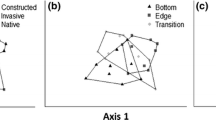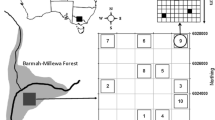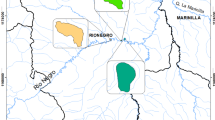Abstract
We conducted an assessment of seed banks in 8 playa lakes on the Southern High Plains of Texas. The seedling-emergence technique was used to determine species composition in 2 environmental moisture regimes (drawdown and submerged). The Gleasonian model of van der Valk was used to predict field vegetation from floristic composition of the seed bank in each playa lake. Based on life-history characteristics of species found in the seed-bank, we predicted the composition of playa vegetation during May, June, and August for 2 years under 3 moisture regimes (dry, moist, flooded). Twenty-six of the 39 species found in the seed-bank were annuals that were able to exploit the rapidly changing moisture regime of playas. Although, seedling densities differed among playas, the model adequately predicted the composition of vegetation in the playas. As environmental variability increased (more annual wet-dry fluctuations), the model became less reliable. To improve the model for playas, we suggest inclusion of frequency, depth, and longevity of flooding in the model.
Similar content being viewed by others
Literature Cited
Baskin, J.M. and C.C. Baskin 1989. Physiology of dormancy and germination in relation to seed bank ecology. p. 53–66.In M.A. Leck, V.T. Parker, and R.L. Simpson (eds.) The Ecology of Soil Seed Banks. Academic Press, Inc., San Diego, CA, USA.
Berthelsen, P.S., L.M. Smith, and C.L. Coffman. 1989. CRP land and game bird production in the Texas High Plains. Journal of Soil and Water Conservation 44:504–507.
Bolen, E.G., L.M. Smith, and H.L. Schramm, Jr. 1989. Playa lakes: prairie wetlands of the Southern High Plains. BioScience 39:615–623.
Conover, W.J. 1980. Practical Nonparametric Statistics. 2nd edition. John Wiley, New York, NY, USA.
Correll, D.S. and M.C. Johnston. 1979. Manual of the Vascular Plants of Texas. University of Texas at Dallas Press, Richardson, TX, USA.
Godfrey, R.K. and J.W. Wooten. 1981. Aquatic Plants of Southeastern United States: Dicotyledons. University of Georgia Press, Athens, GA, USA.
Haukos, D.A. and L.M. Smith. 1992. Ecology of playa lakes. U.S. Fish and Wildlife Service, Office of Information Transfer, Fort Collins, CO, USA. Waterfowl Management Handbook Leaflet 13.3.7.
Keddy, P.A. and A.A. Reznicek. 1982. The role of seed banks in the persistence of Ontario’s coastal plain flora. American Journal of Botany 69:13–22.
Leck, M.A. 1989 Wetland seed banks p. 283–305.In M.A. Leck, V.T. Parker, and R.L. Simpson (eds.) The Ecology of Soil Seed Banks. Academic Press, Inc., San Diego, CA, USA.
Leck, M.A. and K.J. Graveline 1979. The seed bank of a freshwater tidal marsh. American Journal of Botany 66:1006–1015.
McNeill, J. 1981. Nomenclatural problems inPolygonum. Taxon 30:630–641
Nelson, R.W., W.J. Logan, and E.C. Weller 1983. Playa wetlands and wildlife on the Southern Great Plains: a characterization of habitat. FWS/OBS-83/28. U.S. Fish and Wildlife Service, Washington, DC, USA.
Osterkamp, W.R. and W.W. Wood. 1987. Playa-lake basins on the Southern High Plains of Texas and New Mexico: I. hydrologic geomorphic and geologic evidence for their development. Geological Society of America Bulletin 99:215–223.
Pielou, E.C. 1984. The Interpretation of Ecological Data: a Primer of Classification and Ordination. John Wiley and Sons, New York, NY, USA.
Poiani, K.A. and W.C. Johnson. 1988. Evaluation of the emergence method in estimating seed bank composition of prairie wetlands. Aquatic Botany 32:91–97.
Poiani, K.A. and W.C. Johnson. 1989. Effect of hydroperiod on seed-bank composition in semipermanent prairie wetlands. Canadian Journal of Botany 67:856–864.
Reeves C.C., Jr. 1966. Pluvial lake basins of west Texas. Journal of Geology 74:269–291.
Rowell, C.M., Jr. 1971. Vascular plants of the playa lakes of the Texas Panhandle and South Plains. Southwestern Naturalist 15: 407–417.
Salisbury, E.J. 1942. The reproductive capacity of plants. Studies in quantitative biology. Bell, London, England.
Salisbury, E.S. 1970. The pioneer vegetation of exposed muds and its biological features. Philosophical Transactions of the Royal Society of London, Series B 259:207–255.
Simpson, R.L., M.A. Leck, and V.T. Parker. 1989 Seed banks: general concepts and methodological issues. p. 3–8.In M.A. Leck, V.T. Parker, and R.L. Simpson (eds.) The Ecology of Soil Seed Banks. Academic Press, Inc., San Diego, CA, USA.
Smith, L.M. and J.A. Kadlec. 1983. Seed banks and their role during drawdown of a North American marsh. Journal of Applied Ecology 20:673–684.
Smith, L.M. and J.A. Kadlec. 1985. Predictions of vegetation change following fire in a Great Salt Lake marsh. Aquatic Botany 21:43–51.
Thompson, K. 1978. The occurrence of buried viable seeds in relation to environmental gradients. Journal of Biogeography 5:425–430.
Thompson, K. and J.P. Grime. 1979. Seasonal variation in the seed banks of herbaceous species in ten contrasting habitats. Journal of Ecology 67:893–921.
van der Valk, A.G. 1981. Succession in wetlands: a Gleasonian approach. Ecology 62:688–696.
van der Valk, A.G. and C.B. Davis. 1978. The role of seed banks in the vegetation dynamics of prairie glacial marshes. Ecology 59: 322–335.
van der Valk, A.G. and R.L. Pederson. 1989. Seed banks and the management and restoration of natural vegetation p. 329–346.In M.A. Leck, V.T. Parker, and R.L. Simpson (eds) The Ecology of Soil Seed Banks. Academic Press, Inc., San Diego, CA, USA.
Welling, C.H., R.L. Pederson, and A.G. van der Valk. 1988. Recruitment from the seed bank and the development of zonation of emergent vegetation during a drawdown in a prairie wetland. Journal of Ecology 76:483–496.
Zedler, P.H. 1987. The ecology of southern California vernal ponds: a community profile. Biological Report 85(7.11). U.S. Fish and Wildlife Service, Washington, DC, USA.
Author information
Authors and Affiliations
Rights and permissions
About this article
Cite this article
Haukos, D.A., Smith, L.M. Seed-bank composition and predictive ability of field vegetation in playa lakes. Wetlands 13, 32–40 (1993). https://doi.org/10.1007/BF03160863
Received:
Revised:
Accepted:
Issue Date:
DOI: https://doi.org/10.1007/BF03160863




